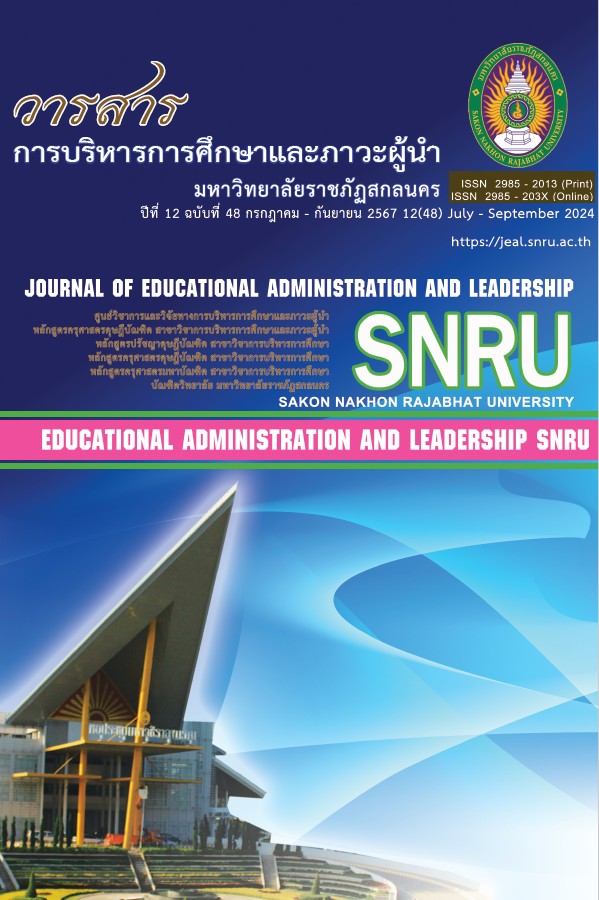

สมรรถนะผู้บริหารยุคดิจิทัลที่ส่งผลต่อความเป็นองค์การแห่งการเรียนรู้ ในโรงเรียน สังกัดสำนักงานเขตพื้นที่การศึกษามัธยมศึกษานครพนม
Executive Competencies in the Digital Era Affecting Learning Organizations in Schools Under the Secondary Educational Service Area Office Nakhon Phanom
ผู้แต่ง
ชยาวุธ เชื้อดวงผุย, ศิกานต์ เพียรธัญญกรณ์, ระภีพรรณ ร้อยพิลา, วีรวัฒน์ คำแสนพันธ์
Author
Chayawut Chueduangpui, Sikan Pienthunyakorn, Rapeepan Royphila, Veerawat Khumsanpan
บทคัดย่อ
การวิจัยครั้งนี้มีความมุ่งหมาย เพื่อศึกษา เปรียบเทียบ หาความสัมพันธ์ อำนาจพยากรณ์สมรรถนะผู้บริหารยุคดิจิทัลที่ส่งผลต่อความเป็นองค์การแห่งการเรียนรู้ในโรงเรียน สังกัดสำนักงานเขตพื้นที่การศึกษามัธยมศึกษานครพนม และหาแนวทางการพัฒนาสมรรถนะผู้บริหารยุคดิจิทัลที่ส่งผลต่อความเป็นองค์การแห่งการเรียนรู้ กลุ่มตัวอย่างที่ใช้ในการวิจัย ได้แก่ ผู้บริหารและครูผู้สอน ปีการศึกษา 2566 จำนวน 318 คน จำแนกเป็นผู้บริหาร จำนวน 102 คนและครูผู้สอน จำนวน 216 คน กำหนดขนาดกลุ่มตัวอย่างโดยใช้ตาราง Krejce and Morgan และใช้การสุ่มแบบแบ่งชั้น (Stratified Random Sampling) โดยใช้ขนาดสถานศึกษาเป็นชั้น (Strata) เครื่องมือที่ใช้เป็นแบบสอบถามมาตราส่วนประมาณค่า 5 ระดับ ประกอบด้วยแบบสอบถามสมรรถนะผู้บริหารยุคดิจิทัล มีค่าอำนาจจำแนก 0.386 – 0.859 มีค่าความเชื่อมั่นเท่ากับ 0.965 แบบสอบถามความเป็นองค์การแห่งการเรียนรู้ มีค่าอำนาจจำแนก 0.533 – 0.924 มีค่าความเชื่อมั่นเท่ากับ 0.983 และแบบสัมภาษณ์เพื่อหาแนวทางพัฒนา สถิติที่ใช้ในการวิเคราะห์ข้อมูลได้แก่ ความถี่ ร้อยละ ค่าเฉลี่ย และส่วนเบี่ยงเบนมาตรฐาน การทดสอบทีแบบกลุ่มตัวอย่างเป็นอิสระจากกัน การหาค่าความสัมพันธ์ การวิเคราะห์ค่าความแปรปรวนแบบทางเดียว และการวิเคราะห์การถดถอยพหุคูณแบบทีละขั้นตอน ผลการวิจัย พบว่า 1. สมรรถนะผู้บริหารยุคดิจิทัล โดยรวมอยู่ในระดับมากที่สุด 2. ความเป็นองค์การแห่งการเรียนรู้ โดยรวมอยู่ในระดับมากที่สุด 3. สมรรถนะผู้บริหารยุคดิจิทัลจำแนกตามสถานภาพการดำรงตำแหน่ง ขนาดโรงเรียนและประสบการณ์ในการทำงานโดยรวมแตกต่างกันอย่างมีนัยสำคัญทางสถิติที่ระดับ .01 4. ความเป็นองค์การแห่งการเรียนรู้ จำแนกตามสถานภาพการดำรงตำแหน่ง และประสบการณ์ในการทำงานโดยรวมแตกต่างกันอย่างมีนัยสำคัญทางสถิติที่ระดับ .01 แต่ขนาดโรงเรียนโดยรวมมีความแตกต่างอย่างมีนัยสำคัญที่ระดับ .05 4. ความเป็นองค์การแห่งการเรียนรู้ จำแนกตามสถานภาพการดำรงตำแหน่ง และประสบการณ์ในการทำงาน โดยรวมแตกต่างกันอย่างมีนัยสำคัญทางสถิติที่ระดับ .01 แต่ขนาดโรงเรียนโดยรวมมีความแตกต่างอย่างมีนัยสำคัญที่ระดับ .05 5. สมรรถนะผู้บริหารยุคดิจิทัลโดยรวม กับความเป็นองค์การแห่งการเรียนรู้โดยรวมพบว่ามีความสัมพันธ์ในทางบวกอย่างมีนัยสำคัญทางสถิติที่ระดับ .01 6. สมรรถนะผู้บริหารยุคดิจิทัล ที่นำมาวิเคราะห์จำนวน 5 ด้าน ที่สามารถการพยากรณ์ความเป็นองค์การแห่งการเรียนรู้ โดยมีนัยสำคัญทางสถิติที่ระดับ .01 ได้แก่ ด้านการเป็นผู้บริหารและการบริหารจัดการอย่างมืออาชีพ (X1) ด้านความมุ่งมั่นในการทำงานและพัฒนางานอย่างต่อเนื่อง (X4) ด้านการแก้ปัญหาและการตัดสินใจ (X5) และด้านการสื่อสารและความร่วมมือทางดิจิทัล (X2) โดยมีอำนาจพยากรณ์ ร้อยละ 45.2 และมีความคลาดเคลื่อนมาตรฐานของการพยากรณ์ เท่ากับ ± 0.16022 7. แนวทางที่เหมาะสมในการพัฒนาสมรรถนะผู้บริหารยุคดิจิทัลที่ส่งผลความเป็นองค์การแห่งการเรียนรู้ พบว่าด้านที่ต้องนำมาพัฒนาสมรรถนะผู้บริหารยุคดิจิทัลของผู้บริหาร จำนวน 4 ด้าน คือ 1) ด้านการเป็นผู้บริหารและการบริหารจัดการอย่างมืออาชีพโดย ผู้บริหารควรกำหนดวิสัยทัศน์ของสถานศึกษาให้มีความชัดเจน 2) ด้านการสื่อสารและความร่วมมือทางดิจิทัล ผู้บริหารจะต้องมีเครือข่ายหรือสร้างเครือข่ายโดยใช้การสื่อสารด้านดิจิทัลเพื่อสื่อสารที่ชัดเจนและมีประสิทธิภาพ 3) ด้านความมุ่งมั่นในการทำงานและพัฒนางานอย่างต่อเนื่อง ผู้บริหารต้องศึกษาหาความรู้ด้านเทคโนโลยีใหม่ ๆ เพื่อนำมาปรับใช้ในระบบการทำงาน 4) ด้านการแก้ปัญหาและการตัดสินใจของผู้บริหารยุคดิจิทัล ผู้บริหารจะต้องสามารถนำข้อมูลมาใช้ในการแก้ปัญหาและตัดสินใจในการทำงานอย่างสร้างสรรค์
Abstract
This research aimed to study, compare, and examine a correlation, predictable power of administrators’ competence in the digital era toward learning organizations in schools, affiliated with the Secondary Educational Service Area Office of Nakhon Phanom, and find the procedures of competency development of administrators in the digital era affecting learning organizations. The samples used in the research conduct were a total 318 of administrators and teachers, divided into 102 administrators and 216 teachers in the academic year 2023. The sample size was determined by Krejce and Morgan and randomized by Stratified Random Sampling based on the use of the Strata method of the school sizes. The research instruments used were a five-rating scale questionnaire comprising a form of development and a form of administrators’ competence in the digital era with a value of discrimination power in the range of 0.386 – 0.859, and a reliability of 0.965. As a questionnaire of the learning organizations, its value of discrimination power was in the range of 0.533 – 0.924, and a reliability of 0.983. The statistics used for data analysis were frequency, percent, mean, and standard deviation, independent samples t - test, correlations, One - Way ANOVA, and stepwise multiple regression analysis. The findings were revealed as follows. 1. The competence of administrators in the digital era was at the highest level overall. 2. Learning organizations were at the highest level overall. 3. The competence of administrators in the digital era, classified by position status, sizes of schools, and working experiences were statistically significant different at the level of. 01 overall. 4. Being the learning organizations, categorized by position status and working experiences was a statistically significant difference at the level of .01 as a whole. The school sizes were statistically significantly different at the level of .05 as a whole. 5. The competence of administrators in the digital era and learning organizations found that they were positively correlated with statistically significant at the level of .01 overall. 6. The competence of administrators in the digital era, taken to analyze the 5 aspects that could predict the learning organizations was statistically significant at the level of .01. They included the aspects of being administrators and professional administration (X1), working intention, and continual working development (X4), solving problems and making a decision (X5), communication and collaboration (X2) with a value of discrimination power of 45.2 percent, and the Standard Error of Estimate for prediction was equal to ± 0.16022. 7. The proper procedures on the competency development of administrators in the digital era affecting learning organizations found that there were 4 aspects needed to develop the competence of administrators as follows. 1) The aspect of being administrators and professional administration, the administrators should determine a clear vision of schools. 2) The aspect of communication and digital collaboration, administrators should have a network or create a network using digital communication for clear and effective communication. 3) The aspect of working intention and continual working development, administrators should acquire knowledge of new technology for applying in a working system. 4) The aspect of solving problems and making a decision of administrators in the digital era should be able to use data to solve problems and creatively make decisions for work.
คำสำคัญ
สมรรถนะผู้บริหารยุคดิจิทัล, ความเป็นองค์การแห่งการเรียนรู้Keyword
Competence of Administrators in The Digital Era, Learning OrganizationsNotice: Undefined variable: dataSet in /var/www/html/ArticleView.php on line 116
Notice: Trying to access array offset on value of type null in /var/www/html/ArticleView.php on line 116
บทความทุกบทความเป็นลิขสิทธิ์ของ
Notice: Undefined variable: dataSet in /var/www/html/ArticleView.php on line 116
Notice: Trying to access array offset on value of type null in /var/www/html/ArticleView.php on line 116
เท่านั้น
กำลังออนไลน์: 19
วันนี้: 0
เมื่อวานนี้: 1,549
จำนวนครั้งการเข้าชม: 1,172,919
อาคารบัณฑิตวิทยาลัย ชั้น 2 ตำบลธาตุเชิงชุม อำเภอเมือง จังหวัดสกลนคร 47000
โทร/
แฟกซ์ 0-4297-0093
บรรณาธิการ: รองศาสตราจารย์ ดร.ไชยา ภาวะบุตร
ติดต่อ/สอบถาม: นายธีรเวทย์ เพียรธัญญกรณ์
โทร: 0-4297-0093